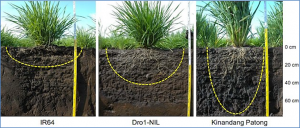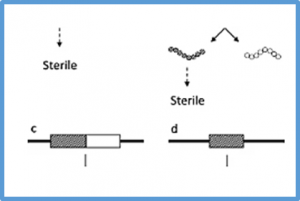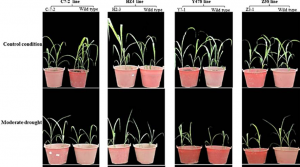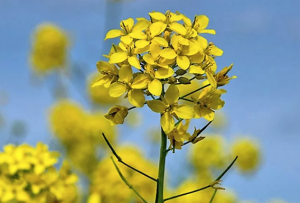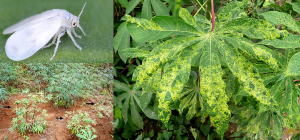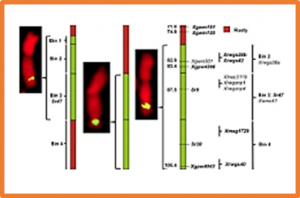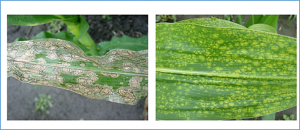Rice is the second most produced crop worldwide, but is highly susceptible to drought. Micro-organisms can potentially alleviate the effects of drought. The aim of the present study was to unravel the genetic factors involved in the rice-microbe interaction, and whether genetics play a role in rice drought tolerance. For this purpose, the composition of the root mycobiota was characterized in 296 rice accessions (Oryza sativa L. subsp. indica) under control and drought conditions.
Cytoplasmic male sterility (CMS) is an increasingly important issue within the context of hybrid seed production. Its genetic framework is simple: S-cytoplasm for male sterility induction and dominant allele of the restorer-of-fertility gene (Rf) for suppression of S. However, breeders sometimes encounter a phenotype of CMS plants too complex to be explained via this simple model. The molecular basis of CMS provides clue to the mechanisms that underlie the expression of CMS.
The genes enconding proteins containing plasma membrane proteolipid 3 (PMP3) domain are responsive to abiotic stresses, but their functions in maize drought tolerance remain largely unknown. In this study, the transgenic maize lines overexpressing maize ZmPMP3g gene were featured by enhanced drought tolerance; increases in total root length, activities of superoxide dismutase and catalase, and leaf water content; and decreases in leaf water potential, levels of O2-·and H2O2, and malondialdehyde content under drought.
Rapeseed (Brassica napus L.) is an essential oil crop that accounts for a considerable share of global vegetable oil production. Nonetheless, studies on functional genes of B. napus are lagging behind due to the complicated genome and long growth cycle, this is largely due to the limited availability of gene analysis and modern genome editing-based molecular breeding. In this study, we demonstrated a short-cycle semi-winter-type Brassica napus ‘Sef1’ with very early-flowering and dwarf phenotype, which has great potential in large-scale indoor planting.
Cassava mosaic disease is caused by a complex of whitefly-transmitted begomoviruses, which often occur in co-infections. These viruses have bipartite genomes consisting of DNA-A and DNA-B that are encapsidated into separate virions. Individual viruses exist in plants and whitefly vectors as populations comprising both genome segments, which can occur at different frequencies. Both segments are required for infection, and must be transmitted for virus spread to occur.
Three durum wheat (Triticum turgidum L. subsp. durum) lines, RWG35, RWG36, and RWG37 carrying slightly different Aegilops speltoides introgressions, but each carrying the Sr47 stem rust resistance gene, were backcrossed to three durum and three hard red spring (HRS) wheat (Triticum aestivum L.) cultivars to produce 18 backcross populations. Each population was backcrossed to the recurrent parent six times and prepared for yield trials to test for linkage drag.
Durian (Durio zibethinus), which yields the fruit known as the "King of Fruits," is an important economic crop in Southeast Asia. Several durian cultivars have been developed in this region. In this study, we resequenced the genomes of three popular durian cultivars in Thailand, including Kradumthong (KD), Monthong (MT), and Puangmanee (PM) to investigate genetic diversities of cultivated durians. KD, MT, and PM genome assemblies were 832.7, 762.6, and 821.6 Mb, and their annotations covered 95.7, 92.4, and 92.7% of the embryophyta core proteins, respectively.
Leaf rolling is a crucial agronomic trait to consider in rice (Oryza sativa L.) breeding as it keeps the leaves upright, reducing interleaf shading and improving photosynthetic efficiency. The SEMI-ROLLED LEAF 1 (SRL1) gene plays a key role in regulating leaf rolling, as it encodes a glycosylphosphatidylinositol-anchored protein located on the plasma membrane. In this study, we used CRISPR/Cas9 to target the second and third exons of the SRL1 gene in the indica rice line GXU103, which resulted in the generation of 14 T0 transgenic plants with a double-target mutation rate of 21.4%. After screening 120 T1 generation plants, we identified 26 T-DNA-free homozygous double-target mutation plants.
Drought is one of the most serious stresses affecting rice growth. Drought stress causes accelerated senescence, reduced fertility, and subsequent reductions in crop yield. Eukaryotic translation elongation factor EF1A is an important multifunctional protein that plays an essential role in the translation of eukaryotic proteins. In this study, we localized and cloned the OsEF1A gene in rice (Oryza sativa) in order to clarify its role in drought tolerance and yield
Lesion mimics are a phenotype of leaf micro-spotting in maize (Zea mays L.), which can be early signs of biotic or abiotic stresses. Dissecting its inheritance is helpful to understand how these loci behave across different genetic backgrounds. Here, 538 maize recombinant inbred lines (RILs) segregating for a novel lesion mimic were quantitatively phenotyped in Georgia, Texas, and Wisconsin.


 Curently online :
Curently online :
 Total visitors :
Total visitors :
